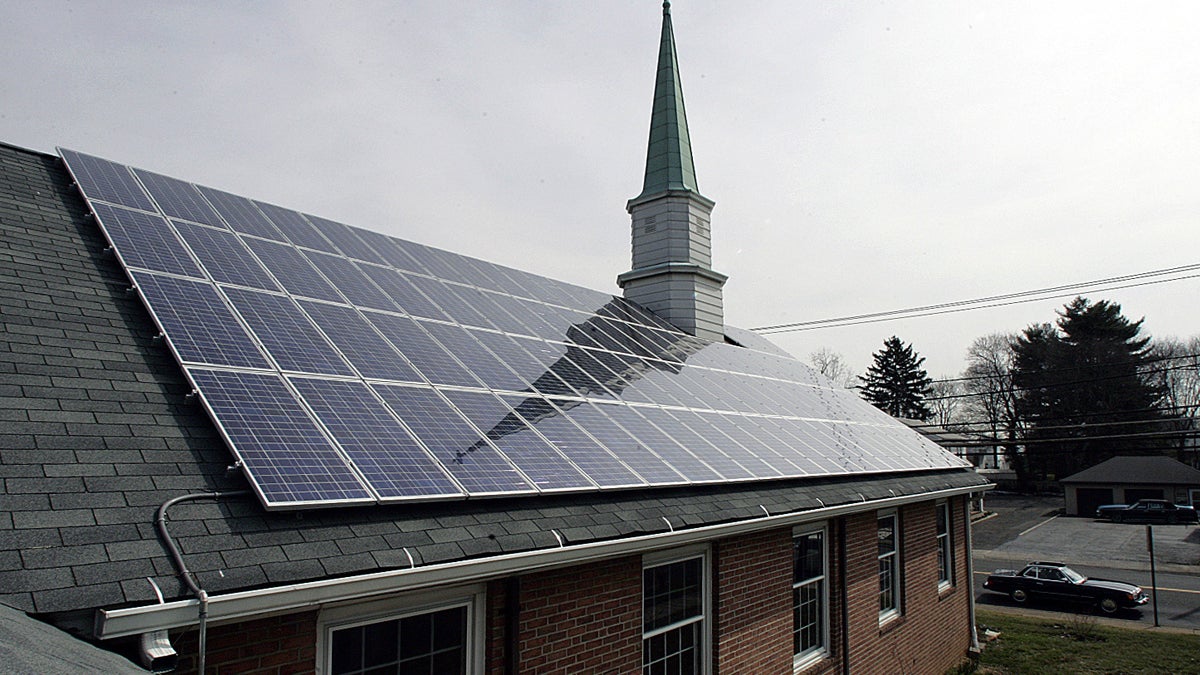Taking steps to create a greener Catholic church
Listen
(AP File Photo/Mel Evans)
Pope Francis’ recent announcement about climate change was revelatory for many, but to some Catholics, respect for the natural environment was already part of their faith.
Pope Francis was not the first religious leader to call for action on climate change when he published his encyclical earlier this summer.
But his high-profile words do have a unique potential to unify and inspire people who have been working toward sustainability in the name of faith at a grassroots level for years.
A green congregation in Wayne
After service Sunday morning, congregants chat and catch up at the Central Baptist Church, a congregation of about 200 people in Wayne, Pennsylvania.
Some peruse a table at the back of the basement sanctuary where fair-trade coffee and chocolate and energy-efficient light bulbs are laid out for sale.
“We sell fair-trade products and other environmentally responsible products,” said Chuck Marshall, a member of the ecology mission group at the church. “The light bulbs are to help people reduce their carbon dioxide emissions.”
The ecology group is encouraging church members to switch to LED bulbs and wind power at home and pay to plant trees in El Salvador. Their goal is to offset the carbon dioxide that is emitted as congregants travel to church each week.
A poster behind the table shows the congregation’s progress, with puffs of smoke representing the 33 tons of carbon dioxide emitted each year from cars carrying the faithful to service.
“As we get commitments to reduce carbon dioxide emissions, we erase one of the puffs and put in blue sky, to show that we’re cleaning up the environment,” Marshall said.
The ecology group has brought the church building itself to carbon neutrality through a combination of offsets, energy-efficient upgrades and renewable energy.
Now, they are encouraging congregants to offset their car emissions.
Church member Jane Dugdale, who is involved with the church’s climate initiative, sees environmentalism as an extension of her faith.
“Most of the wars that are going on now are for resources and will continue to be, and so we are called to take care of the Earth, God’s creation,” Dugdale said.
Chuck Marshall also sees environmental protection as a moral issue.
“Whenever I come across environmental issues I think in terms of the people that are hurt, damaged by it, and then the people who caused that, and so I want to correct that imbalance,” Marshall said.
Religious environmentalism rooted in local communities
Central Baptist Church is a good example of the kind of grass-roots organizing that has led the environmental movement in faith communities.
The church is affiliated with Interfaith Power & Light, a network of faith communities fighting climate change. The group started in the late 1990s in California and has since spread to congregations in nearly 40 states.
State chapters help arrange energy audits at houses of worship and encourage the use of renewable energy.
“Religious environmentalism, from my standpoint, has largely been driven by local actions,” said John Grim, co-director of the Forum on Religion and Ecology at Yale.
Grim believes the Pope’s climate letter has the power to change that.
“Religious environmentalism is no longer seen as simply a political act but rather… is now affirmed by religious leadership and associated with the teachings in the tradition,” Grim said.
The Pope’s letter is also potentially more impactful than statements that came before it, from leaders including the Dalai Llama and Archbishop of Canterbury, due to the centralized nature and sheer size of the Catholic Church.
“It comprises one of the world’s largest institutional networks, including thousands upon thousands of churches, schools, [and] hospitals,” said Jim McCartin, director of the Fordham Center on Religion and Culture and a historian of the Catholic Church in the U.S. “Even if half of those choose to go all in in the issues that Pope Francis is raising that would have an enormous impact.”
There is historical precedent for Catholic teachings driving social movements outside the walls of the church. For example, Papal encyclicals in the late 1800s and early 1900s that outlined the rights of workers to organize gave a boost to the U.S. labor movement.
“[They helped] affirm a movement already on the ground among Catholics and others in the United States to secure the rights of workers to just pay, to agreeable hours, and a whole range of other things,” McCartin said.
Many less popular Catholic teachings fail to gain a foothold among the general public. However, McCartin believes when church teachings dovetail with changing public sentiment, as in the case of climate change, top-level proclamations like the Pope’s can help feed into social movements on the ground.
WHYY is your source for fact-based, in-depth journalism and information. As a nonprofit organization, we rely on financial support from readers like you. Please give today.



